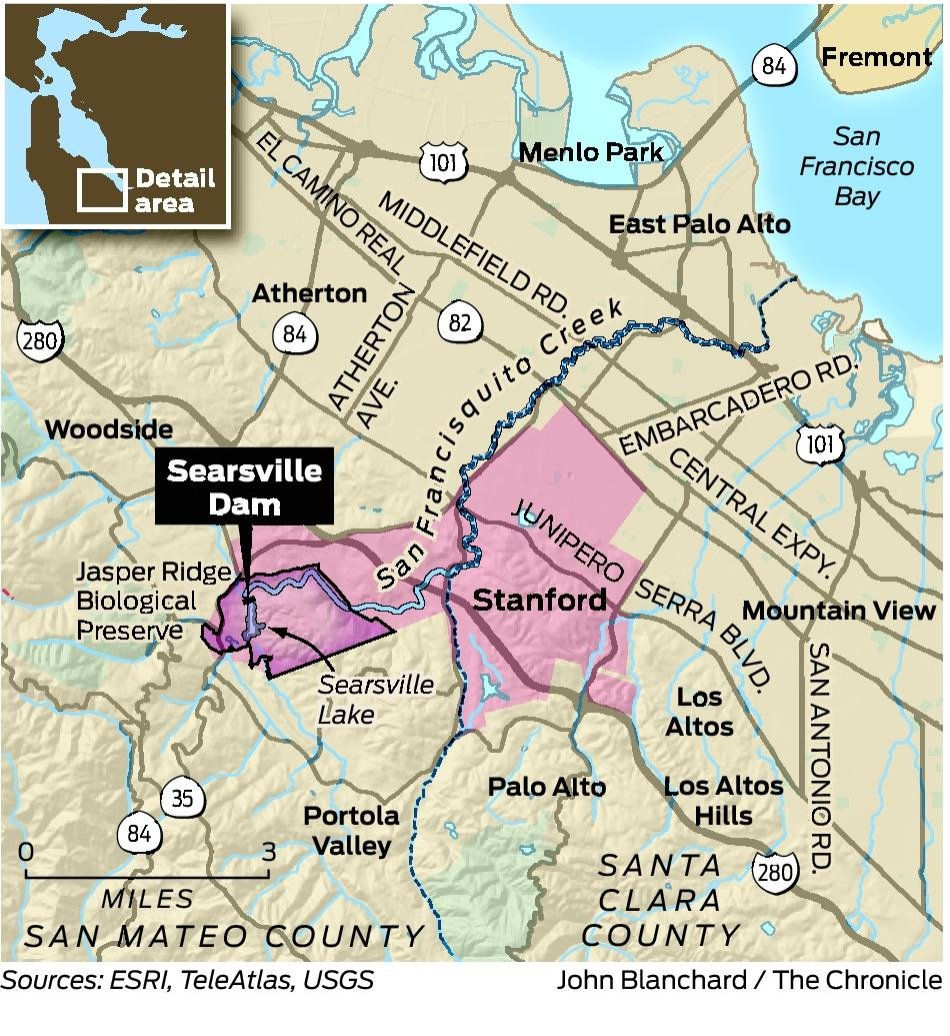Stanford dam blamed for diverting water from creek
- Carolyn Lochhead
- Apr 9, 2014
- 3 min read
Updated: Jan 4, 2022
San Francisquito imperiled, group says
April 9, 2014
Stanford University is not generally known as an environmental villain that dams rivers.
Yet a prominent national environmental group has named San Francisquito Creek, which drains the eastern slope of the Santa Cruz Mountains, as the fifth-most-endangered river in the United States and pinned the blame squarely on Stanford's Searsville Dam.
Built in 1892 and choked nearly to the brim with sediment, the dam blocks the migration of one of the bay's last remaining populations of native steelhead trout, the group American Rivers said in a report being released Wednesday. The reservoir irrigates campus lawns and the university golf course.

Administrative director of Jasper Ridge biological preserve Philippe S. Cohen, Ph.D., and Matt Stoecker of Beyond Searsville Dam on top of the dam in Portola Valley, Calif., on Monday, May 25, 2010. Liz Hafalia/The Chronicle
"Stanford is constantly talking about how sustainable their campus is, and what Searsville mostly feeds is a huge golf course," said Matt Stoecker, a biologist who founded Beyond Searsville Dam in Palo Alto in 1998 to get the dam removed.
No water diversions
Stanford spokeswoman Lisa Lapin said in an e-mail that the university has not diverted any water from the creek in more than a year because of the drought.
"When there have been diversions from Searsville, it has only been during periods of extraordinary flows from a recent storm," she said. "In that case, the water is used for agricultural irrigation, fire protection and landscape irrigation."
She said that because the reservoir is so heavily silted, "almost all water passes through as it would flow through the creek."
American Rivers listed San Francisquito Creek in part because Stanford has promised to come up with a plan for the dam by the end of this year. Removing it is one of the options.

Topping the group's endangered list is the San Joaquin River, 70 percent of which is diverted to farm and urban uses.
The diversions have endangered its salmon and steelhead populations and dried up more than 100 miles of the river. House Republicans approved legislation earlier this year to end a restoration plan for the river because of the drought, but the Senate has not acted.
Critical decision
San Francisquito Creek "is unique because it remains one of the only San Francisco Bay streams that is not confined to a concrete channel," American Rivers' report said.
The creek escaped that fate, according to the report, because it marks the boundary between San Mateo and Santa Clara counties, which "could never agree on a plan for its channelization."
"The decision at the end of this year is completely critical and will determine the future of the watershed," said Kerri McLean, associate director of California river restoration for American Rivers.
Lapin said Stanford "has been actively studying options for the future of the Searsville Dam, of which removal is just one option among many being evaluated."

An overlook of Searsville reservoir at Jasper Ridge biological preserve in Portola Valley, Calif., on Monday, May 25, 2010. Liz Hafalia/The Chronicle
These options include doing nothing, modifying the dam, removing it, dredging the reservoir, building fish ladders, or tearing a hole at the bottom of the dam to allow some water to flow.
Stanford owns much of the upstream watershed. The area around the dam is home to the university's Jasper Ridge Biological Preserve, an 1,189-acre area used to study how ecosystems are affected by human activity.
A position paper issued by the preserve in 2007 urged that the dam be allowed to silt up, citing the ecological benefits of the reservoir, including "key habitat for migratory and breeding waterfowl" and "important foraging resources for bats."
Removing the dam would be a "massive undertaking" that would disrupt the area, the paper said.
'Incredibly expensive'
Stoecker dismissed as "ridiculous" the university's arguments that the reservoir provides bird habitat and serves climate change science. He said algae in the reservoir is creating potent methane emissions and that replacing an open water reservoir with natural wetland and riparian habitat would act as a natural sponge to absorb floodwaters.
An advisory committee made of local and regional government officials, federal agencies and environmental groups is studying the issue along with the university.
"It's a much more complicated issue than almost anyone would assume," said Pat Burt, a Palo Alto City Councilman who is on the committee. "It's an incredibly expensive set of propositions whatever alternative is looked at, I can tell you."
Sediment, flooding
One problem is what to do with the accumulation of sediment behind the dam. Another is the potential for flooding in Palo Alto, East Palo Alto and Menlo Park should the dam be removed.

Closeup of Searsville Dam at Jasper Ridge biological preserve in Portola Valley, Calif., on Monday, May 25, 2010. Liz Hafalia/The Chronicle
Len Materman, executive director of the San Francisquito Creek Joint Powers Authority, a regional body that seeks to reduce floodplain risk, said there are other water storage options to replace the dam. But he asked, "Is it easy, is it cheap, is it a known quantity? Not exactly."







Comments